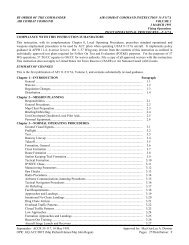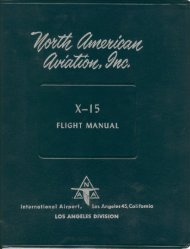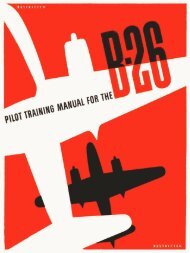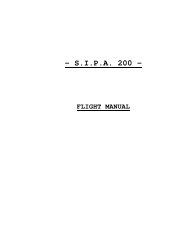to holding the wing level, because the directional stabilityproduces a noticeable turning tendency with onewing down.WARNINGCare should be taken to avoid excessivethe ailerons.(5) ROUGH AIR OPERATION.use ofW The ailerons and rudder can be used withoutconcern regarding excessive loads. It is almost impossibleto damage the system without a deliberateattempt to do so. The forces required are smallenough and the resultant responses large enough tomaintain ample control of the airplane.(Q) In the case of the elevators, however, caremust be exercised to assure smooth operation. Inthunderstorms, squalls, and in or near extremelyturbulent cumulous clouds, it is possible to developexcessive load factors with the elevators unless propercare is exercised.(.0 Operation in rough air should be made onthe basis of holding constant the air speed with theelevator. Corrections for changes in altitude mustbe done with power, and for very rapidly rising aircurrents, it may be necessary to lower the landinggear.(g) The airplane should not be dived through acloud layer or through rough air at the maximumdiving speed, nor should high-speed flight be attemptedin rough air.(6) OBTAINING MAXIMUM PERFORMANCE.(!D The ceiling and climb at 35,000 feet are asgreat or greater than that of many fighter airplanes,but the high speed is not as great as most fighters atnormal altitudes; therefore, in order to outperformany enemy at 35,000 feet it will be necessary to outclimbhim rather than to outdistance him.(Q) The increase of speed obtained by nosingthe airplane down below the horizontal at rated powerand at any high power condition is smaller than thatobtained by fighters.(g) In order to obtain maximum climb, the followingtechnique should be used:1. Maintain the proper climbing air speed(135 mph indicated).~. In any emergency whatever, such as beingpursued by the enemy, engine speed should be increasedto 2500 rpm. The increase in rpm has a veryappreciable effect on increasing propeller efficiencyand rate of climb under conditions of climbing speedand high altitude, and, in addition, is not detrimentalto the engine. The pilot should avoid the use of lessthan 2500 rpm when primarily interested in a highrate of climb at high altitudes.~. 21,300 rpm has been determined to be themaximum operating turbo speed with a 5 percent overspeedallowance in emergencies. This would providean emergency rating of 22,400 rpm. At any altitudegreater than 30,000 feet and at any power obtained inautomatic rich (with 2300 rpm or 2500 rpm, full throttleand turbos set for manifold pressures indicated in thefollowing table), the exhaust gas temperatures aredropping rapidly and it is very unlikely that criticaltemperatures will be approached. The following tentativelydetermined manifold pressures will permitsafe operation of the turbo under the given conditions:Manifold Pressures giving Manifold Pressures givingrated power at 2300 engine military power at 2500 engineAltitude rpm and 21,300 turbo rpm rpm and 21,300 turbo rpmS.L. 39.0 I>,°.....47 in. I""""°I-
NOTEThis table is based on the best present availableinformation for maximum performance at55,000-pound gross weight with carburetor airfilters closed. All four turbo installations arenot identica,l and hence, operation accordingto the above table will not result in identicalturbo rpm for all engines.i. The outboard engines have higher criticalaltitudes than the inboards by approximately 2000to 3000 feet, and the inboard engine without boilers inthe stack has a 1500-foot higher critical altitude thanthe engine with the boilers in the stack. The criticalaltitude ofthe outboard engines as far as limiting turborpm is concerned is 31,000 feet.Q. The above table actually applies only to theoutboard engines. However, the differences betweenthe inboard and outboard engines are covered by themargin of safety incorporated in the design of theturbo itself. Even though 22,400 rpm are allowablefor military power operation, the right-hand columnof the above table, is made for only 21,300 rpm.(7) LANDING. - During the approach for landingvery little change in elevator trim will be required.As the flaps are lowered the airplane becomes slightlytail heavy, but if it is trimmed slightly nose heavy at147 mph with flaps up, it will be properly trimmedat 120 mph with flaps down. This is a satisfactoryapproach speed for gross weights below 50,000 pounds.Q.. STALLS.(1) Stalling characteristics are very satisfactory.Under no condition is there any sharp tendency to roll.Yawing is sufficiently suppressed to make any rollingat the stall of a very mild nature. Under all conditionsa stall warning of several miles per hour is indicatedby buffeting of the elevators.(2) A pitching motion started by the elevatorsshould be damped slowly. It will easily reduce theair speed well below the stall unless it'is deliberatelystopped.(3) Full flap reduces the stalling speed about15 mph for gross weights between 40,000 and 45,000pounds, but full military power for the same loadingconditions may reduce the stalling speed another 15mph. Accidental or deliberate yawing will increasethe stalling speed and increase any tendency to rollat the stall.(4) The ailerons have a tendency to overbalanceand reverse effectiveness at the stall. For example,if the left wing tends to drop at the stall and rightaileron control is applied in an attempt to raise theleft wing, the aileron operating forces will tend todecrease and cause full aileron deflection, but theresponse will be an increase in the roll to the left.THE PROCEDURE IN RECOVERING FROM A STALLIS TO HOLD THE AILERONS NEUTRAL AND RE-FRAIN ENTIRELY FROM THEIR USE.(5) Procedure for r-ecoveringfrom a stall is normal.The air speed for normal flight must first be regainedby smooth operatiort of the elevators. Thismay put the airplane into a dive of 30 degrees or less.During the process of regaining air speed the ruddermay be used to maintain laterally level flight fol' lateralcontrol, but not until the air speed is regained.RECOVERY FROM THE DIVE MUST BE DONE IN ASMOOTH MANNER. Failure to make a smooth recoverymay be a restalling of the airplane or a structuralfailure, both due to excessive load factors.(6) Air -speed increase necessary to regain normalflight need not generally be more than 20 mph, andpossibly, after practice, even less.Q.. SPINS. - Inadvertent spinning is very unlikely,as stability and damping are very high. The airplaneis not designed for spinning, and this maneuver shouldnever be attempted.g,. DIVES. - Airplanes having modified elevatorsare limited to a maximum diving speed of 2'70 mph.Those airplanes whose elevators have not been modifiedare restricted to 220 mph maximum diving speed.See Warning Placard!When diving, it is essential that the sensitivity ofthe elevator trim tab be kept constantly in mind. Inmaking dives the elevator trim tabs must be set duringthe dive to maintain zero elevator force and must beused with great care during recovery.!:,. PRECAUTIONS.(1) MAXIMUM LOAD.(l!,) B-<strong>17</strong>F airplanes, with modified landing gearand added chord-wise wing tip tanks, can be flown up toand including a gross weight of 64,500 pounds, withthe following restrictions:(Q) At 64,500 pounds, the extra wing tip tanksmust be full to obtain the effect of a relieving load onthe wings in flight. Care must be exercised in taxyingavoiding rough ground. Take-offs, above a grossweight of 56,000 pounds may be made only on smoothfields or prepared runways. All pivot turns on onewheel, while taxying, will be avoided.(£) All B-<strong>17</strong> type airplanes, equipped with extrawingtipchord-wise tanks, mustbe operated in accordancewith (Q) preceding, whenever the wing tiptanks are more than half full. Maximum permissibleindicated air speed of B-<strong>17</strong>F airplanes, with extrawing tip tanks full, must be limited to 230 mph, whenloaded to 64,500 pounds. Maximum maneuver permissible'at 64,500 pounds; positive, 2.056; negative,1.22; landing gear, 2.1.36










